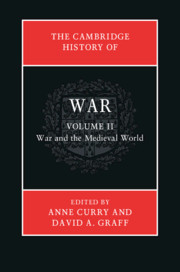Book contents
- The Cambridge History of War
- The Cambridge History of War
- Copyright page
- Contents
- Illustrations
- Maps
- Notes on contributors
- Introduction to volume II
- Part I Foundations, c.600–1000 ce
- Part II Interactions, c.1000–1300 ce
- Part III Nations and Formations, c.1300–1500 ce
- 13 Western Europe, 1300–1500
- 14 Warfare and Italian states, 1300–1500
- 15 The reconquest and the Spanish monarchies
- 16 The Byzantine empire and the Balkans, 1204–1453
- 17 Ottoman expansion and military power, 1300–1453
- 18 India, c.1200–c.1500
- 19 Southeast Asia, 1300–1540
- 20 Japan, 1200–1550
- 21 The Americas
- Part IV Comparisons: Cross-Cultural Analysis
- Select bibliography
- Index
19 - Southeast Asia, 1300–1540
from Part III - Nations and Formations, c.1300–1500 ce
Published online by Cambridge University Press: 25 September 2020
- The Cambridge History of War
- The Cambridge History of War
- Copyright page
- Contents
- Illustrations
- Maps
- Notes on contributors
- Introduction to volume II
- Part I Foundations, c.600–1000 ce
- Part II Interactions, c.1000–1300 ce
- Part III Nations and Formations, c.1300–1500 ce
- 13 Western Europe, 1300–1500
- 14 Warfare and Italian states, 1300–1500
- 15 The reconquest and the Spanish monarchies
- 16 The Byzantine empire and the Balkans, 1204–1453
- 17 Ottoman expansion and military power, 1300–1453
- 18 India, c.1200–c.1500
- 19 Southeast Asia, 1300–1540
- 20 Japan, 1200–1550
- 21 The Americas
- Part IV Comparisons: Cross-Cultural Analysis
- Select bibliography
- Index
Summary
The end of the thirteenth century and the early decades of the fourteenth century witnessed the end of Southeast Asia’s classical period, that age when the empires of Pagan (Burma), Angkor (Cambodia), Dai Viet (northern Vietnam), and Sri Vijaya (in the Malay Archipelago) thrived and introduced the region’s religions, political models, and cultural standards. The thirteenth-century invasions of Mongol armies coming out of Yuan China encouraged, but did not cause, the collapse of most of these states, although changes in the application of the Chinese tribute system may have played a substantial role in the fall of Sri Vijaya. On the mainland, however, Mongol intervention was merely disruptive and did not represent meaningful conquest. Instead, administrative weaknesses and trade dislocation contributed to political fragmentation followed by internecine war among the myriad successor states. This fighting would only end with the reemergence of large-scale empires from the middle to the end of the sixteenth century. The period between 1300 and 1540 thus represented a phase of near constant warfare, due both to the multiplicity of competing polities and the administrative weaknesses that worked against sustained political centralization. By the end of the period, the formation of new empires established the political terrain for warfare in the centuries to come.
- Type
- Chapter
- Information
- The Cambridge History of War , pp. 507 - 522Publisher: Cambridge University PressPrint publication year: 2020
- 2
- Cited by

